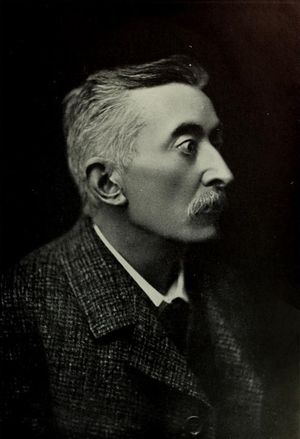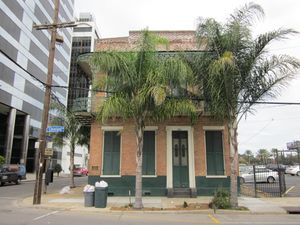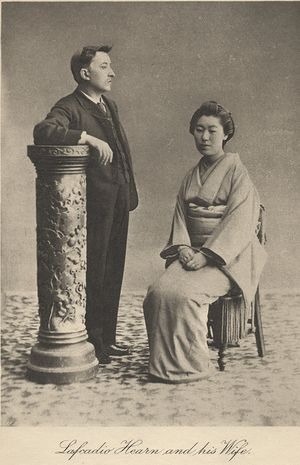لافكاديو هيرن
پاتريك لافكاديو هيرن Patrick Lafcadio Hearn Koizumi Yakumo (小泉八雲) | |
|---|---|
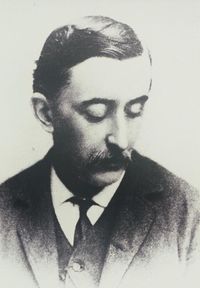 لافكاديو هيرن عام 1889 | |
| وُلِد | 27 يونيو 1850 لافكادا، الولايات المتحدة للجزر الأيونية |
| توفي | 26 سبتمبر 1904 طوكيو، اليابان |
| الاسم الأدبي | كويزومي ياكومو |
| اللغة | الإنگليزية |
| العرق | أيرلندي، يوناني، ياباني |
| الجامعة الأم | اوشاو كولدج |
| الزوج | ألثيا ("ماتي") فولي كويزومي سِـِتسو |
پاتريك لافكاديو هيرن Patrick Lafcadio Hearn (/hɜːrn/؛ و. 27 يونيو 1850 – ت. 26 سبتمبر 1904)، واشتهر أيضاً بالاسم الياباني كويزومي ياكومو (小泉 八雲)، هو كاتب عالمي، اشتهر بكتبه عن اليابان، وخاصة مجموعته عن الأساطير وقصص الأشباح اليابانية، مثل كوايدان: قصص ودراسات الأشياء الغريبة. في الولايات المتحدة، اشتهر هيرن أيضاً لكتاباته عن مدينة نيو اورلينز التي أقام فيها عشر سنوات.
حياته
حياته المبكرة
وُلد هيرن في لفكادا، (أصل اسمه الأوسط)، إحدى الجزر الأيونية اليونانية. كان ابن الميجور تشارلز بوش هيرن (من مقاطعة اوفالي، أيرلندا) وروزا أنطونيو كاسيماتي، إمرأة يونانية من نسب كيثيري نبيل من جهة الأب، أنطوني كاسيماتي. كان والده مقيم في لفكادا أثناء الاحتلال البريطاني للجزيرة. عُمد لافكاديو باسم پاتريشيو لافكاديو هيرن في كنيسة الروم الأرثوذكس. ليس معروفاً إذا ما كان والداه قد تزوجا زواجاً شرعياً، واعتبرته الروابط الپروتستانتية من جهة والده مولود خارج إطار الزواج. قد يكون هذا، لعدم اعتراف الپروتستانت بمراسم زواج الروم الأرثوذكس.[1]
ذهب هيرن إلى دبلن، أيرلندا، وعمره سنتين، حيث نشأ في ضاحية راثمينس. وكان لبقية أفراد عائلته اهتمامات فنية. عمه كان واحد من أشهر فناني باربيزون، وبالرغم من ذلك فلم يكن مشهوراً كرسام، ربما لافتقاده الطموح الشخصي. تلقى هيرن الصغير تعليماً غير منتظماً، لكنه عام 1865 التحق باوشاو كولدج الكاثوليكية في درم. جُرح هيرن أثناء اللعب في سنوات مراهقته، فقد على إثره الرؤية في عينه اليسرى.
الهجرة
التعاليم الدينية التي تلقاها هيرن سرعان ما ذهبت، وفي سن التاسعة عشر أُرسل ليعيش في الولايات المتحدة، حيث أقام في كينكيناتي، اوهايو. لفترة، عاش حياة فقيرة.[2] وفي النهاية التقى صدفة بالرسام الإنگليزي وكاتب المقالات هنري واتكين. بمساعدة واتيكن بدأ هيرن عمل صحفي محدود.
بتنمية موهبته ككاتب، سرعان ما حصل هيرن على عمل كمراسل في صحيفة كينكيناتي إنكويرير اليومية، وعمل بها من 1872 حتى 1875. لتميزها بالكتابة الحرة المبدعة كانت الصحيفة واحدة من أكثر الصحف مبيعاً، واشتهر هيرن بتغطيته للجرائم المحلية، ولتطرقه لموضوعات حساسة عن المواطنين الفقراء في المدينة. اختارته ليبراري اوف أمريكا كواحد من أفضل صحفيي الجرائم، "Gibbeted," for inclusion in its two-century retrospective of American True Crime, published in 2008.
استمر هيرن في العمل بالصحافة والرصد والكتابة. وبينما كان في كينكيناتي تزوج[بحاجة لمصدر] أليثا ("ماتي") فولي، إمرأة أمريكية سوداء، وكان هذا تصرف غير قانوني في ذلك الوقت. عندما اكتشفت الفضيحة ونشرت، طُرد من الصحيفة وذهب للعمل بجريدة "كينكيناتي التجارية".[بحاجة لمصدر] تطلقا عام 1877.
عام 1874، هيرن والشاب هنري فارني، الذي أصبح فيما بعد رسام شهير في الغرب الأمريكي، اشتركا في كتابة، رسم، ونشر صحيفة أسبوعية عن الفن، الأدب، النقد وكان اسمها Ye Giglampz وصدر منها تسعة أعداد.
نيو اورلينز
في خريف 1877، ترك هيرن كينكيناتي وانتقل إلى نيو اوريلينز، لويزيانا، حيث كان في البداية يكتب موجزاً لاكتشافاته في "بوابة المناطق المدارية" لجريدة "كينكيناتي التجارية".
عاش في نيو اورلينز لما يقارب عشر سنوات، كتب أولااً في صحيفة "دايلي سيتي أيتم" وبعدها في "تايمز ديموكرات". The vast number of his writings about New Orleans and its environs, many of which have not been collected, include the city's Creole population and distinctive cuisine, the French Opera, and Louisiana Voodoo. His writings for national publications, such as Harper's Weekly and Scribner's Magazine, helped create the popular reputation of New Orleans as a place with a distinct culture more akin to that of Europe and the Caribbean than to the rest of North America. His best-known Louisiana works are Gumbo Z'herbes: A Dictionary of Creole Proverbs (date unavailable) circa 1885, Little Dictionary of Creole Proverbs in Six Dialects (1885); La Cuisine Créole (1885), a collection of culinary recipes from leading chefs and noted Creole housewives who helped make New Orleans famous for its cuisine; and Chita: A Memory of Last Island, a novella based on the hurricane of 1856 first published in Harper's Monthly in 1888. He also published in Harper's Weekly the first known written article (1883) about Filipinos in the United States, the Manilamen or Tagalags, one of whose villages he had visited at Saint Malo, southeast of Lake Borgne in Saint Bernard Parish, Louisiana.
Hearn was little known then, and even now he is little known for his writing about New Orleans, except by local cultural devotees. However, more books have been written about him than any former resident of New Orleans except Louis Armstrong.[3]
Hearn's writings for the New Orleans newspapers included impressionistic descriptions of places and characters and many stern, vigorous editorials denouncing political corruption, street crime, violence, intolerance, and the failures of public health and hygiene officials. Despite the fact that he is credited with "inventing" New Orleans as an exotic and mysterious place, his obituaries of the vodou leaders Marie Laveau and Doctor John Montenet are matter-of-fact and debunking. A selection of Hearn's writings was collected in S. Fredrick Starr's book Inventing New Orleans: Writings of Lafcadio Hearn, published by the University Press of Mississippi.[4]
Harper's sent Hearn to the West Indies as a correspondent in 1887. He spent two years in Martinique and produced two books: Two Years in the French West Indies and Youma, The Story of a West-Indian Slave, both in 1890.
حياته في اليابان
In 1890, Hearn went to Japan with a commission as a newspaper correspondent, which was quickly terminated. It was in Japan, however, that he found a home and his greatest inspiration. Through the goodwill of Basil Hall Chamberlain, Hearn gained a teaching position during the summer of 1890 at the Shimane Prefectural Common Middle School and Normal School in Matsue, a town in western Japan on the coast of the Sea of Japan. The Lafcadio Hearn Memorial Museum and his old residence are still two of Matsue's most popular tourist attractions. During his fifteen-month stay in Matsue, Hearn married Koizumi Setsu, the daughter of a local samurai family, with whom he had four children.[5] He became a naturalized Japanese, assuming the name Koizumi Yakumo, in 1896 after accepting a teaching position in Tokyo.
During late 1891, Hearn obtained another teaching position in Kumamoto, Kyūshū, at the Fifth Higher Middle School, where he spent the next three years and completed his book Glimpses of Unfamiliar Japan (1894). In October 1894, he secured a journalism job with the English-language newspaper Kobe Chronicle, and in 1896, with some assistance from Chamberlain, he began teaching English literature at Tokyo Imperial University, a job he had until 1903. In 1904, he was a professor at Waseda University. On 26 September 1904, he died of heart failure at the age of 54 years. His grave is at the Zōshigaya Cemetery in Toshima, Tokyo.
In the late 19th century, Japan was still largely unknown and exotic to Westerners. However, with the introduction of Japanese aesthetics, particularly at the Paris Exposition Universelle of 1900, Japanese styles became fashionable in Western countries. Consequently, Hearn became known to the world by his writings concerning Japan. In later years, some critics would accuse Hearn of exoticizing Japan, but because he offered the West some of its first descriptions of pre-industrial and Meiji Era Japan, his work has historical value.[6]
عهده
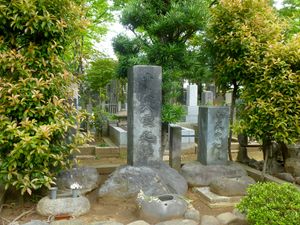
Admirers of Hearn's work have included Ben Hecht,[7] John Erskine, and Malcolm Cowley.[8]
The Japanese director Masaki Kobayashi adapted four Hearn tales into his 1965 film, Kwaidan. Some of his stories have been adapted by Ping Chong into his puppet theatre, including the 1999 Kwaidan and the 2002 OBON: Tales of Moonlight and Rain.
Hearn's life and works were celebrated in The Dream of a Summer Day, a play that toured Ireland during April and May 2005, which was staged by the Storytellers Theatre Company and directed by Liam Halligan. It is a detailed dramatization of Hearn's life, with four of his ghost stories included.
Yone Noguchi is quoted as saying about Hearn, "His Greek temperament and French culture became frost-bitten as a flower in the North."[9]
There is also a cultural center named for Hearn at the University of Durham.
Hearn was a major translator of the short stories of Guy de Maupassant.[10]
In Ian Fleming’s 1964 novel You Only Live Twice, James Bond retorts to his nemesis Blofeld's comment of "Have you ever heard the Japanese expression kirisute gomen?" with "Spare me the Lafcadio Hearn, Blofeld."
أعماله
كتب هيرن عن الموضوعات اليابانية التالية
- (1894). Glimpses of Unfamiliar Japan,
- (1895). Out of the East: Reveries and Studies in New Japan,
- (1896). Kokoro: Hints and Echoes of Japanese Inner Life,
- (1897). Gleanings in Buddha-Fields: Studies of Hand and Soul in the Far East,
- (1897). The Boy who Drew Cats, (Houghton Mifflin, Boston).
- (1898). Exotics and Retrospectives,
- (1898). Japanese Fairy Tales, (and sequels).
- (1899). In Ghostly Japan,
- (1900). Shadowings,
- (1900). Japanese Lyrics,
- (1901). A Japanese Miscellany,
- (1902). Kottō: Being Japanese Curios, with Sundry Cobwebs,
- (1903). Kwaidan: Stories and Studies of Strange Things (Later made into the movie Kwaidan by Masaki Kobayashi)
- (1904). Japan: An Attempt at Interpretation,
- (1905). The Romance of the Milky Way and other studies and stories,
Posthumous Anthologies
- (1918). Karma,
- (1966). Japan's Religions: Shinto and Buddhism,
- (1984). Writings from Japan: An anthology, (Penguin Books)
- (2007). Lafcadio Hearn's Japan: An Anthology of His Writings on the Country and Its People, (Tuttle)
Other
- (1911). Leaves from the Diary of an Impressionist, Houghton Mifflin Company.
- (1915). Interpretations of Literature, Dodd, Mead and Company.
- (1921). On Reading in Relation to Literature, The Atlantic Monthly Press, Inc.
- (1928). Lectures on Shakespeare, Hokuseido Press.
- (1968). Books and Habits; from the Lectures of Lafcadio Hearn, Books for Libraries Press.
- (2002). Lafcadio Hearn's America: Ethnographic Sketches and Editorials, University Press of Kentucky.
- (2009). American Writings, Library of America.
انظر أيضاً
المصادر
- ^ Cott, Jonathan (1992), Wandering Ghost: The Odyssey of Lafcadio Hearn, Kodansha International.
- ^ Grace, Kevin (Jan 4, 2012). "Legendary Locals of Cincinnati". Arcadia Publishing. p. 25. Retrieved 2013-05-07.
- ^ "A chronicle of Creole cuisine", Chronicle (Houston), http://www.chron.com/disp/story.mpl/life/food/side/4544683.html.
- ^ Starr, S. Frederick (2001), Inventing New Orleans: Writings of Lafcadio Hearn, University Press of Mississippi, ISBN 1-57806-353-1
- ^ Kazuo, Iwao, Kiyoshi, and Suzuko: Katharine Chubbuck, ‘Hearn, (Patricio) Lafcadio Carlos (1850–1904)’, Oxford Dictionary of National Biography, Oxford University Press, 2004
- ^ Komakichi, Nohara, The True Face of Japan, (1936, 1st ed.)
- ^ MacAdams, William (1995), Ben Hecht, Barricade, p. 34, ISBN 1-56980-028-6.
- ^ Cowley, Malcolm (1949), "Introduction", in Goodman, Henry, The Selected Writings of Lafcadio Hearn, Citadel.
- ^ Noguchi, Yone (1910), Lafcadio Hearn in Japan, New York: Mitchell Kennerley.
- ^ "Bibliography", Lafcadio Hearn, Trussel, http://www.trussel.com/hearn/byhearn.htm.
قراءات إضافية
- Amenomori, Nobushige (1905). "Lafcadio Hearn, the Man," The Atlantic Monthly, October 1905.
- Bisland, Elizabeth (1906). The Life and Letters of Lafcadio Hearn, Vol. II, New York: Houghton, Mifflin & Company.
- Bronner, Milton, ed. (1907), Letters from the Raven: Being the Correspondence of Lafcadio Hearn with Henry Watkin.
- Cott, Jonathan (1992), Wandering Ghost: The Odyssey of Lafcadio Hearn, Kodansha International.
- Dawson, Carl (1992). Lafcadio Hearn and the Vision of Japan, Johns Hopkins University Press.
- Gould, George M. (1908), Concerning Lafcadio Hearn, George W. Jacobs & Company.
- Hearn, Lafcadio (2001), Starr, S Frederick, ed., Inventing New Orleans: Writings of Lafcadio Hearn, University Press of Mississippi, http://www.upress.state.ms.us/catalog/spring2001/inventing_new_orleans.html.
- Hearn, Lafcadio (2009), "Some Chinese Ghosts, Chita, Two Years in the French West Indies, Youma and Selected Journalism and Letters", in Benfey, Christopher, American Writings, Library of America.
- Kennard, Nina H (1912), Lafcadio Hearn, New York: D. Appleton & Co, http://www.archive.org/details/lafcadiohearn00kennrich.
- Kunst, Arthur E. (1969). Lafcadio Hearn, Twayne Publishers.
- Langton, D. H. (1912). "Lafcadio Hearn: Journalist and Writer on Japan," The Manchester Quarterly, Vol. XXXI.
- Lurie, David (2005), "Orientomology: The Insect Literature of Lafcadio Hearn (1850–1904)", in Pflugfelder, Gregory M; Walker, Brett L, JAPANimals: History and Culture in Japan's Animal Life, University of Michigan Press.
- Mais, S. P. B. (1920). "Lafcadio Hearn." In Books and their Writers, Grant Richards, Ltd.
- McWilliams, Vera (1946). Lafcadio Hearn, Houghton Mifflin Company.
- Miner, Earl Roy (1958). The Japanese Tradition in British and American Literature, Princeton University Press.
- Monaham, Michael (1922). "Lafcadio Hearn," An Attic Dreamer, Mitchell Kennerley.
- More, Paul Elmer (1905). "Lafcadio Hearn." In Shelburne Essays, Second Series, G. P. Putnam's Sons.
- Narita, Tatsushi (1911), TS Eliot and his Youth as 'A Literary Columbus', Nagoya: Kougaku Shuppan.
- Noguchi, Yone (1905). "Lafcadio Hearn, A Dreamer," National Magazine, Vol. XXII, No. 1.
- Noguchi, Yone (1910), Lafcadio Hearn in Japan, New York: Mitchell Kennerley.
- Pulvers, Roger (January 19, 2000), "Lafcadio Hearn: Interpreter of Ttwo Disparate Worlds", Japan Times (Trussel), http://www.trussel.com/hearn/pulvers.htm.
- Rexroth, Kenneth (1977), The Buddhist Writings of Lafcadio Hearn.
- Rothman, Adam (2008), "Lafcadio Hearn in New Orleans and the Caribbean", Atlantic Studies 5 (2); republished in New Orleans in the Atlantic World: Between Land and Sea, Routledge, 2013.
- Setsu, Koizumi (1918). Reminiscences of Lafcadio Hearn, Houghton Mifflin Company.
- Starrs, Roy (2006), "Lafcadio Hearn as Japanese Nationalist" (PDF), Nichibunken Japan Review: Journal of the International Research Center for Japanese Studies (JP: Nichibun) (18): 181–213, http://shinku.nichibun.ac.jp/jpub/pdf/jr/JN1805.pdf.
- Thomas, Edward (1912). Lafcadio Hearn, Houghton Mifflin Company.
وصلات خارجية
- Works by Lafcadio Hearn, at Internet Archive
- Works by Lafcadio Hearn, at Unz.org
- أعمال من Lafcadio Hearn في مشروع گوتنبرگ
- Works by Lafcadio Hearn, at Hathi Trust
- Hearn, Lafcadio, Works, LibriVox, http://librivox.org/newcatalog/search_advanced.php?title=&author=lafcadio+hearn&cat=&genre=&status=complete&type=&language=&date=&reader=&bc=&mc=&action=Search.
- "Lafcadio Hearn and Haiku", Modern haiku, http://www.modernhaiku.org/essays/hearnandhaiku.html.
- Hearn's influence in literature
- "A Journey to Lefcadio Hearn's birthplace", GRJP Web, http://archives.grjpweb.com/lefcada.htm.
- Dirda, Michael, "The Ghost Stories of Lafcadio Hearn", Library without walls, Barnes & Noble, http://bnreview.barnesandnoble.com/t5/Library-Without-Walls/The-Ghost-Stories-of-Lafcadio-Hearn/ba-p/3536.
- Lafcadio Hearn's papers at the Albert and Shirley Small Special Collections Library, University of Virginia
- Japan and the Japanese as Seen by Foreigners
- Lafcadio Hearn
- Articles with unsourced statements from May 2009
- Pages using authority control with unknown parameters
- Persondata templates without short description parameter
- مواليد 1850
- وفيات 1904
- كتاب اللغة الإنگليزية من اليابان
- جامعوا حكايات خرافية
- يونانيون مهاجرون إلى المملكة المتحدة
- بريطانيون مهاجرون إلى الولايات المتحدة
- كتاب يابانيون
- كتاب رعب يابانيون
- فلكلوريون يابانيون
- أمريكان مهاجرون إلى اليابان
- علماء يابانيات
- مواطنون متجنسون في اليابان
- متحولون إلى البوذية
- كتاب قصص أشباح
- مستشارو خارجية الحكومة اليابانية في فترة ميجي
- أشخاص من لفكادا
- كتاب من نيو اورلينز، لويزيانا
- مسيحيون أرثوذكس شرقيون سابقون
- طاقم تدريس جامعة طوكيو
- طاقم تدريس جامعة واسدا
- وفيات بفشل قلبي
